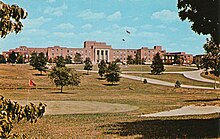Naval Ordnance Laboratory
The Naval Ordnance Laboratory ( NOL ) is a former research facility of the United States Navy in White Oak , Maryland, which was in operation until October 1, 1997 and was devoted to basic research such as magnetism , aerodynamics and explosives in different departments with affiliated laboratories . The 2.9 km 2 site is located approx. 18 km north of Washington, DC and is in use by the US Federal Food and Drug Administration (FDA) as of 2013 . After the end of operations, the tasks were transferred to the Arnold Engineering Development Complex (AEDC), part of the Air Force Test Center on Arnold Air Force Base in the US state of Tennessee .
The Naval Ordnance Laboratory emerged from the Naval Surface Warfare Center in 1944 and was a major research facility in the 1950s and 1960s. The Wind Tunnel Research department (Area 400) dealt with aerodynamics. In this department, from 1948, tests were carried out at supersonic speed with the wind tunnels installed in Peenemünde during the Second World War and newly built in White Oak .
The Magnetic Research Facilities department (Area 200) dealt with topics from the field of magnetism. Among other things, the alloy Bismanol for strong permanent magnets was developed in 1956. The buildings of this department were a bit out of the way in the forest and were made of wood in order to minimize disruptive influences as much as possible. This department was one of the first departments of the complex and emerged during the Second World War from the need to develop defensive procedures against the magnetic mines developed by the Germans and then novel , a form of sea mine with magnetic triggering.
More fundamental developments, the alloys nitinol , a shape memory alloy from the elements nickel and titanium , as well as Terfenol-D , a high- magnetostrictive material of terbium, iron and dysprosium. The designation Nitinol and Terfenol-D are acronyms and represents NI ckel TI tanium N aval O rdnance L aboratory or TER bium FE rrum N aval O rdnance L aboratory and D ysprosium . From the Naval Ordnance Laboratory, numerous important scientists emerged, such as the two-time Nobel Prize winner John Bardeen and the computer pioneer John Atanasoff .
Individual evidence
- ↑ a b WOL - White Oak Laboratory. (PDF; 1.1 MB) Retrieved June 8, 2013 .

